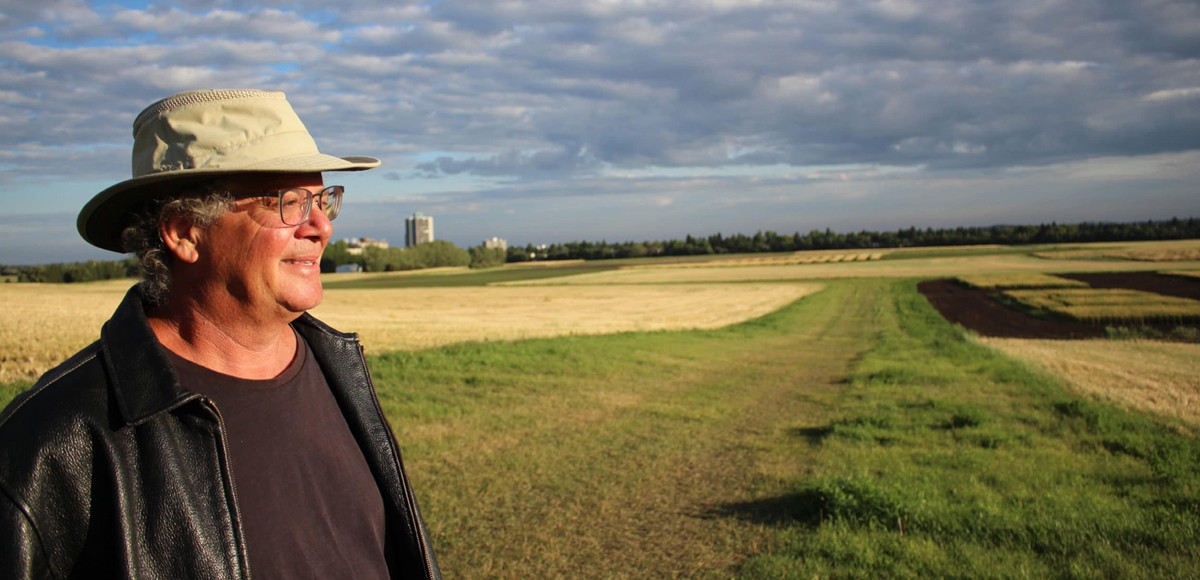Unwheatable

A prolific breeding career winds down
After more than 45 years spent playing in Canada’s farm fields, Dean Spaner is hanging up his trowel. He is well-known for taking a then-overlooked wheat breeding program at University of Alberta (U of A) and turning it into a powerhouse of production. He produced 17 unique wheat varieties across three classes during his tenure as a breeder and professor.
Spaner’s career first started at the U of A in 1977 as a summer student in the canola breeding program, although he completed his undergraduate degree at the University of Guelph. Early in his career, Spaner worked as a canola and soybean breeding technician under the tutelage of Wally Beversdorf, the first person to successfully transfer a triazine resistance gene into canola.
Before his focus shifted exclusively to wheat, he worked for Agriculture and Agri-Food Canada where he co-developed two rutabaga varieties in St. John’s, Newfoundland, and also a corn variety at the University of the West Indies in Trinidad and Tobago.
In 2000, when he took the top wheat job at the U of A, the portfolio, as Spaner notes, was humble to say the least. His expectations were about as low as you could get.
“Our financial backing, especially in the first 10 years compared to Agriculture and Agri-Food Canada, I really didn’t think we’d have the ability to release a variety,” he says.
Nonetheless, Spaner got to work with a part-time technician, a used pickup truck and a decommissioned plot combine from the provincial government. After 13 years, Spaner and his team released Thorsby, a an awnless three-way cross that included international germplasm. Known for its early maturity, stripe-and leaf-rust resistant with good lodging resistance, it is named after the Alberta town his mother and father met.
To this day, the release of Thorsby is one of his most memorable career moments.
“It became grown on a number of acres in the north of Alberta,” he recalls. “I’m very proud of that. We did that on a minimal budget at the beginning.”
A primary aim for Spaner over the years was to elevate the profile of U of A’s breeding program and release quality varieties. With one Canadian Prairie Spring wheat and Special Purpose (SP), along with 15 Canadian Western Red Spring varieties released commercially, it’s clear he achieved his goal.
Following Thorsby, a more regular pool of funding came in, specifically through Agricultural Crop Industry Development Fund (ACIDF) and Western Grains Research Foundation (WGRF). Today, the funding is robust and predictable with the Alberta Wheat Commission (AWC), the Canadian Wheat Research Coalition and others having funded him in a significant way over the last decade.
It’s allowed him to spend more time wearing out the soles of his shoes rather than the backs of his pants.
“I stressed field work way, way more than lab work,” he says. “To me, it was super important. Plant breeding is not done in a lab. It’s done in a field.”
Being at a university, it afforded him the flexibility to take unconventional approaches. Other breeding programs have pragmatic rules to cross elite by elite parents, which will, predictably, result in strong progeny, while simultaneously limiting germplasm.
“Whereas in the university, I can just operate like a madman and I can play games with all the germplasm,” he says.
The Edmonton area fields he toiled in meant any viable variety created would naturally be early maturing as the region is the northernmost breeding program in North America, and the entire world.
“If you combine the yield and early maturity, you’re going to have very early lines and so that was one of our main objectives, and that was supported from the get-go by granting agencies and the Wheat commissions,” he says.
Spaner was also instrumental in developing varieties that were resistant to stripe rust and, later, Fusarium head blight (FHB). He created three disease nurseries by 2007 and allowed variety selection to become much more accurate. ACIDF, WGRF and AWC have all funded projects with Spaner’s program, often in conjunction with Harpinder Randhawa’s soft white wheat breeding program at AAFC Lethbridge, into breeding and genetic studies of stripe rust and FHB resistance. These projects have aided in the development of Western Canada’s scientific infrastructure through graduate student mentorship and the ultimate graduation of scientists. They also led to the development of several varieties with elevated resistance levels to these two diseases, particularly stripe rust.
To bookend his spectacular career, one of Spaner’s final varieties was created in conjunction with CIMMYT, the International Maize and Wheat Improvement Center in Mexico. In Spaner’s words, “it’s the Mecca of wheat breeding.”
Annually, Spaner tested about 2,000 lines from CIMMYT and never had a single successful match for 22 years. Then, a breakthrough with an SP variety.
“We finally got one out of that entire process,” he says with a smile. “This was the first one coming out of CIMMYT materials we tested that exhibited potential in Canada.”
The yet-to-be-fully-commercialized variety dubbed Alotta by SeCan will soon be available to farmers. Spaner notes it’s the single-highest yielding Prairie wheat ever. However, he is quick to deflect praise and makes it clear it’s not just him carrying out this work in isolation. Although he started with a skeleton crew, Spaner has built the program up to eight full- time employees and in summertime it balloons up to 15 with students.
“I do not work alone—no breeder does—and I’m not God,” he says. “I have an incredible crew. You need that to have a happy, productive career and you have to treat your crew well. It’s a great job and lifestyle, and it’s very rewarding.”

